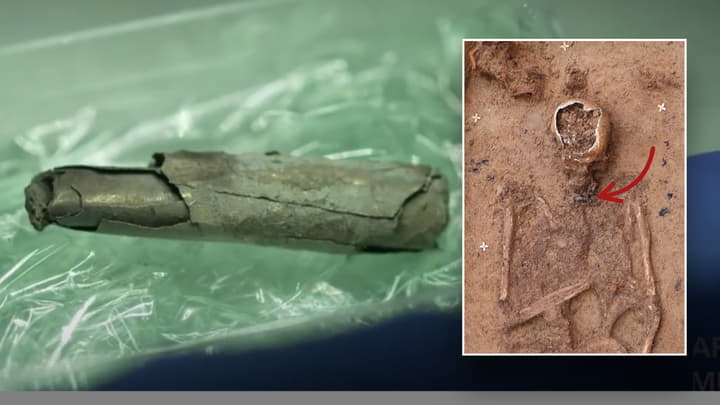Archaeologists Discover Earliest Evidence of Christianity North of the Alps
Archaeologists have uncovered the earliest known evidence of Christianity north of Italy, describing the find as one of the “most important testimonies of early Christianity.” The artifact, known as the Frankfurt silver inscription, is a groundbreaking discovery for understanding the spread of Christianity in the Roman Empire.
What is the Frankfurt Silver Inscription?
The Frankfurt silver inscription, unveiled by the Frankfurt Archaeological Museum, is an engraving on a thin piece of silver foil. It features 18 lines of Latin text and dates back to between 230 and 260 A.D. This artifact, discovered in 2018 in a third-century grave in Hesse, Germany—formerly the Roman city of Nida—has been studied intensively before its public release this month.
The silver foil was wrapped in a small amulet, a protective charm often used in ancient times. The inscription begins with a Christian invocation: “In the name of Saint Titus, Holy, holy, holy! In the name of Jesus Christ, God’s Son!” This introduction firmly identifies it as a Christian artifact. Saint Titus was a first-century Christian missionary and disciple of Paul the Apostle.
Unique Christian Message
The text continues with a protective prayer, asking for divine guardianship over the amulet’s owner. It concludes with a powerful declaration: “The heavenly, the earthly, and the underground, and every tongue confess [to Jesus Christ].”
Remarkably, the inscription is entirely devoid of references to Judaism or paganism—a rarity for its time. Most amulets from the era exhibit a blend of religious elements, including Jewish or pagan symbols. The museum’s press release emphasized this uniqueness, noting that “the amulet is purely Christian,” containing no mention of Yahweh, Israelite forefathers, or pagan deities and demons.
The Challenge of Deciphering the Inscription
Due to the foil’s age and condition, deciphering the text was a meticulous process. The silver had been crumpled for nearly 1,800 years, requiring advanced digital techniques to “unroll” it virtually. Using computed tomography and other high-tech equipment, researchers decrypted the text in May.
Markus Scholz, a professor at Goethe University, led the translation effort, which spanned several months. “Sometimes it took weeks, even months, to come up with the next idea,” Scholz explained. “I collaborated with experts in theology and history, piecing together the text bit by bit.” He described the inscription as “very sophisticated,” highlighting the author’s advanced writing skills.
Significance of the Discovery
The artifact’s purely Christian nature and its Latin script make it exceptionally rare for its time. Scholz noted, “It is unusual that the inscription is completely in Latin. Such inscriptions were typically written in Greek or Hebrew.” The lack of syncretic elements further underscores its significance.
The museum hailed the discovery as “one of the most important testimonies of early Christianity worldwide.” Previous evidence of Christian life in northern Alpine regions only dates back to the fourth century A.D., making this find at least 50 years older than any comparable artifacts.
“So far, there has been no such early, authentic proof of pure Christianity north of the Alps,” the museum’s statement added. While historical accounts hint at early Christian groups in Gaul and parts of Upper Germania during the late second century, concrete evidence has been scarce.
Context in Early Christianity
This discovery sheds light on the early Christian communities that existed within the Roman Empire’s northern regions. The inscription offers a glimpse into the faith and practices of these early believers, providing valuable insights into the spread of Christianity during its formative centuries.
As scholars continue to analyze the Frankfurt silver inscription, its significance for understanding the religious landscape of the ancient Roman Empire will undoubtedly grow.
This article was rewritten by JournosNews.com based on verified reporting from trusted sources. The content has been independently reviewed, fact-checked, and edited for accuracy, neutrality, tone, and global readability in accordance with Google News and AdSense standards.
All opinions, quotes, or statements from contributors, experts, or sourced organizations do not necessarily reflect the views of JournosNews.com. JournosNews.com maintains full editorial independence from any external funders, sponsors, or organizations.
Stay informed with JournosNews.com — your trusted source for verified global reporting and in-depth analysis. Follow us on Google News, BlueSky, and X for real-time updates.













